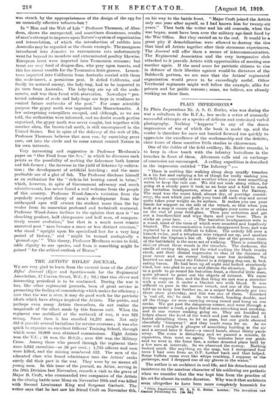THE ARTISTS' RIFLES' JOURNAL.
WE are very glad to learn from the current issue of the Artists' Rifles' Journal (Eyre and Spottisw•oode for the Regimental Association, 17 Craven Street, W.C. 2 ; 9d.) that this clever and interesting periodical is to be continued. During the war it has, like other regimental journals, been of great service in promoting the feeling of comradeship which makes for efficiency ; now that the war is over, it may do good work for the patriotic ideals which have always inspired the Artists. The public, and perhaps even many Artists themselves, do not realize the magnitude of the effort made by this famous unit. When the regiment was mobilized at the outbreak of war, it was 621 strong. Since then it has enrolled 14,291 men. Not only did it provide several battalions for service overseas ; it was also quick to organize an excellent Officers' Training School, through which some 10,000 men obtained commissions. Eight Artists won the V.C. ; 38 won the D.S.O. ; over 600 won the Military Cross. Among those who passed through the regiment there were 5,642 casualties—or 36 per cent. ; 1,745 officers and men were killed, and the missing numbered 532. The men of the educated class who found admittance into the Artists' ranks surely did their part in the war. They were by no means all young men. In this issue of the journal, an Artist, serving in the 56th Division last November, records a visit to the grave of Major B. Croft, who commanded two companies of the Artists in the closing battle near Mons on November 10th and was killed with Second Lieutenant King and Sergeant Garbutt. The writer says that he last saw his friend Croft on November 6th, on his way to the battle front. " Major Croft joined the Artists only one year after myself, so I had known him for twenty-six years." Thus both the writer and his old comrade, when the war began, must have been over the military age-limit fixed by the War Office. But they carried on to the end. It would be a great pity if demobilization were allowed to destroy the ties that bind all Artists together after their strenuous experiences. The Journal will offer them a means of intercommunication. The Regimental Association and the very inexpensive club attached to it provide Artists with opportunities of meeting one another again. If the need arose for patriotic citizens to rise in defence of their liberties against would-be dictators of the Bolshevik pattern, we are sure that the Artists' regimental organization would prove to be exceedingly useful. Other Territorial regiments might well follow the example, alike for private and for public reasons ; some, we believe, are already working on these lines.


































 Previous page
Previous page